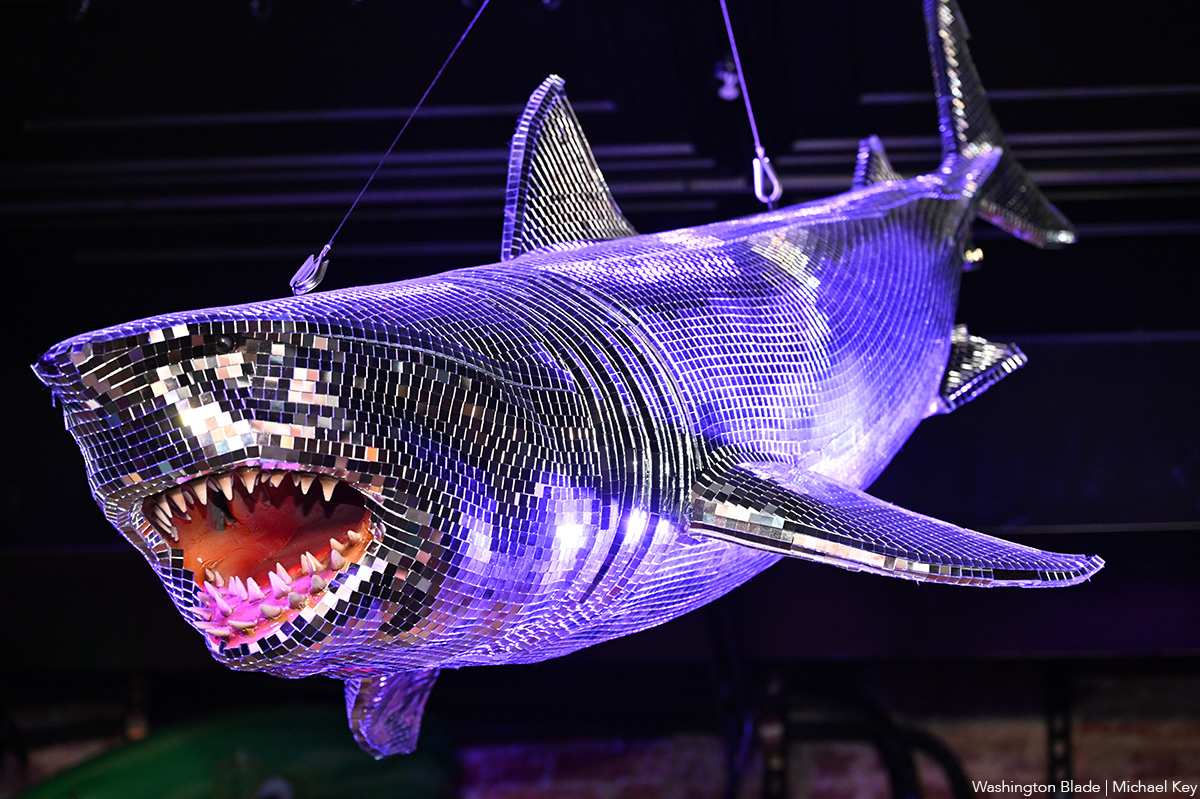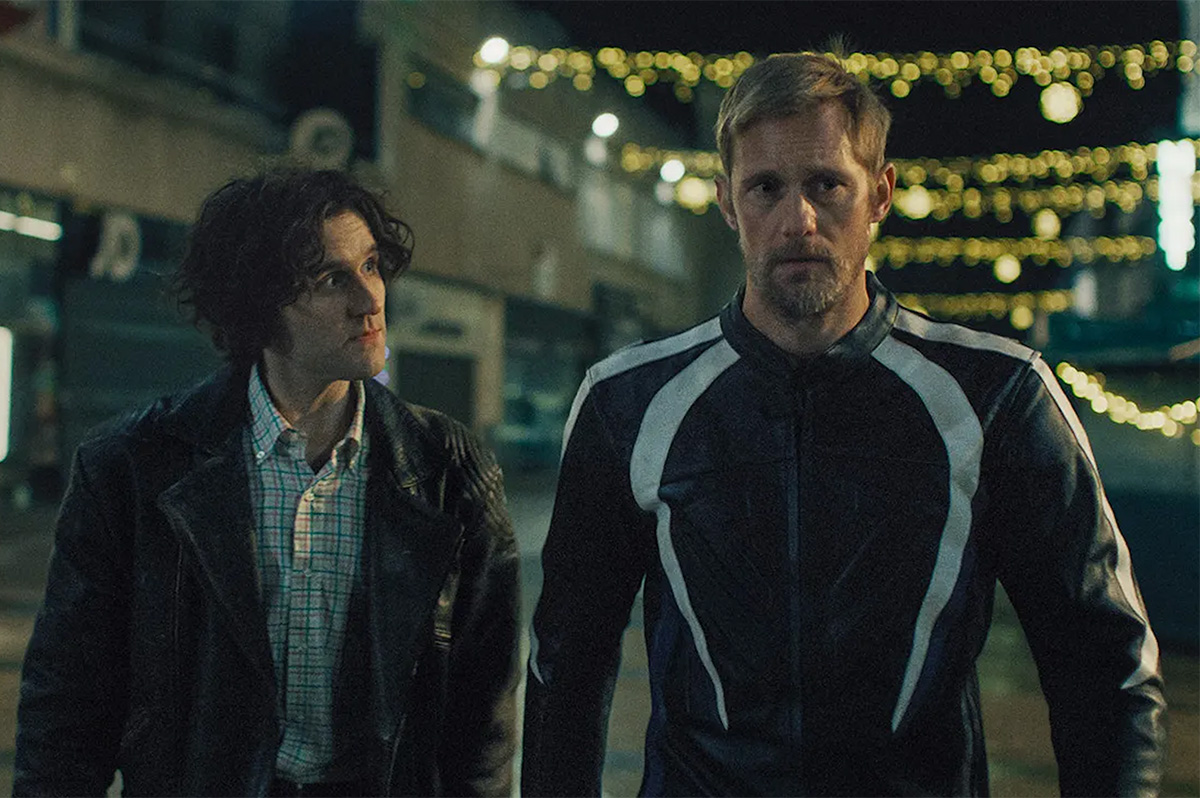Arts & Entertainment
Calendar: Jan. 27


Singer/songwriter, ellen cherry, is Strathmore's Artist in Residence and will be the first of two performances on Wednesday (Photo courtesy Strathmore)
TODAY (Friday)
LezGetTogether presents “Lez Invade” at Local 16 (1602 U St., N.W.) tonight at 6 p.m. LezGetTogether is an online community for LGBT women in the D.C. metro area.
Busboys & Poets will be hosting ASL open mic poetry tonight at 11 p.m. in the Langston Room at its 14th and V streets location (2021 14th St., N.W.). Anyone with sign language knowledge may sign up to recite a poem or sign a song by e-mailing [email protected]. There is a $5 cover.
Black Cat (1811 14th St., N.W.) presents “Get There,” an evening of mashups with Bad Domes tonight at 9:30 p.m. Tickets are $5 and available the night of the show. For more information, visit blackcatdc.com.
The D.C. Gurly Show presents “snOMG!!” with special musical guest Frankie and Betty at Phase 1 (525 8th St., S.E.) tonight at 9 p.m. There is a $10 cover for this 21-and-older event.
Photoworks Gallery at Glen Echo Park (7300 MacArthur Blvd.) presents “Mirror to the World: Documentary Photography 2012,” opening today with a reception from 6 to 9 p.m. The exhibit will be on display through Feb. 27. For more information, visit glenechophotoworks.org.
Strathmore’s Friday Night Eclectic, a mash-up of music and art, presents “The 9,” featuring nine singer/songwriters spearheaded by Justin Trawick at the Mansion at Strathmore (10701 Rockville Pike, North Besthesda) at 8 p.m. The other performers are Becky Warren, Gideon Grove, Adrian Krygowski, Amanda Lee, Victoria Vox, Max Kuzmyak, Mary Alouette and Nita Chawla. Tickets are $10 in advance and can be purchased online at strathmore.org. Doors open at 8 p.m.
Saturday, Jan. 28
Comet Ping Pong (5037 Connecticut Ave., N.W.) is hosting a night of queer punk with performances by Brooklyn’s Little Victory, Philly’s Death Rattle and D.C.’s own Troll Tax tonight from 10:30 p.m. to 1:30 a.m. There is a $10 cover for this all ages show.
The D.C. Roller Girls are have a double header today at the D.C. Armory (2001 E Capitol St., S.E.) starting at 4 p.m. The first bout is between the Cherry Blossom Bombshells and the Majority Whips. The second bout is between the D.C. DemonCats and the Scare Force One. Tickets are $12 at the door, $6 for kids ages 6 to 11 and kids under 6 get in free. For more information, visit dcrollergirls.com.
The Black Cat (1811 14th St., N.W.) has two events going on backstage today. First up is the free event Hellmouth Happy Hour featuring an episode of “Buffy the Vampire Slayer” and drinks specials at 7 p.m. This week’s episode is “Gingerbread.” Then DJ lil’e takes over the space for her ‘80s Alt-Pop Dance night, Right Round. Tickets are $7 and doors open at 9:30 p.m.
Star of “RuPaul’s Drag Race” and “Drag U” Pandora Boxx performs at Town (2009 8th St., N.W.) tonight with music by DJ Chord Bezarra. There’s an $8 cover before 11 p.m. and $12 after for this 21-and-older event. Doors open at 10 p.m.
Green Lantern (1335 Green Court, N.W.) presents an underwear night tonight. Get happy hour prices, normally available from 4 to 8 p.m., for wearing just underwear upstairs from 11 p.m. to 3 a.m.
The Supreme Wig Council presents this year’s “Wig Night Out” tonight at Level One (1639 R St., N.W.) starting at 10 p.m. There is a $10 suggested donation and all the proceeds will go to the Point Foundation, a group that provides financial support, mentoring and more to students who are marginalized due to sexual orientation, gender identity or gender expression. For more information on Point, visit pointfoundation.org.
Sunday, Jan. 29
D.C. Ice Breakers and Burgundy Crescent Volunteers are hosting a buffet brunch and social at Freddie’s Beach Bar (555 South 23rd St., Arlington) today at 11 a.m. The brunch is $19.99 plus tax and tip. Reservations are required. For more information and to make reservations, visit dcicebreakers.com.
“Food for the Soul” brunch is back at Tabaq Bistro (1336 U St., N.W.) today from 1 to 4 p.m. with DJ Mim providing music and performances by Sampson, Lady Redz and Layla Khepri. There is a $5 suggested donation and all proceeds will be donated to Slut Walk D.C.
Today is the last day to see Touchstone Gallery’s (901 New York Ave., N.W.) exhibit, “Into the Wild,” featuring paintings by Paula Lantz. The gallery is open from noon to 5 p.m. For more information, visit touchstonegallery.com.
Monday, Jan. 30
Busboys & Poets presents Monday Night Open Mic Poetry in the Robeson Room of its Shirlington location (4251 S. Campbell Ave., Arlington) at 8 p.m. Wristbands are $4 and will be sold in the Global Exchange store beginning at 10 a.m.
Green Lantern (1335 Green Court, N.W.) hosts Bears Do Yoga from 6:30 to 7:30 p.m. upstairs followed by Queer Pong hosted by Andy from 8 p.m. to midnight and karaoke hosted by Mike at 9:30.
Tuesday, Jan. 31
Samantha Crain plays Red Palace (1212 H St., N.E.) tonight at 8:30 p.m. with Ben Weaver. Tickets are $8 and can be purchased online at redpalacedc.com. Doors open at 8 p.m.
Join Burgundy Crescent Volunteers to help pack safer sex kits from 7 to 9 p.m. tonight at FUK!T’s packing location, Green Lantern, 1335 Green Ct., N.W.
The Chesapeake Squares, a gay square dancing group, are having a mainstream-through-advanced club night tonight at the Waxter Center (1000 Cathedral St.) in Baltimore from 8 to 10 p.m. For more information, visit chesapeakesquares.org.
Wednesday, Feb. 1
Strathmore presents its artist in residence ellen cherry tonight at the Mansion (10701 Rockville Pike, North Bethesda) at 7:30 p.m. in the first of two performances. Tickets are $12 and can be purchased online at strathmore.org. Cherry’s second performance is Feb. 22.
Riot Act Comedy Theater’s (801 E St., N.W.) monthly gay and gay-friendly comedy show “Gay-larious” returns tonight at 8:30 p.m. with Wendy Ho and co-founders Chris Doucette and Zach Toczynski. Tickets are $15 and can be purchased online at riotactcomedy.com.
The Tom Davoren Social Bridge Club for gay bridge players meets tonight for social bridge at the Dignity Center (721 8th Street, S.E.). No partner is needed. Visit lambdabridge.com for details and click on “social bridge in Washington.”
Thursday, Feb. 2
D.C. Lambda Squares, a local gay square dancing group, is having its plus with as-needed mainstream club night tonight from 7:30 to 9:30 p.m. at National City Christian Church (5 Thomas Circle, N.W.). For more information, visit dclambdasquares.org.
The D.C. Center, with the Deaf Abused Women’s Network, Deaf Queer Kaleidoscope and Gallaudet University with sponsorship from Access Interpreting is facilitating a deaf/hard of hearing/deaf-blind LGBT community needs assessment for the area today from 6 to 9 p.m. in the multi-purpose room at Gallaudet (800 Florida Ave., N.E.). For more information, e-mail Alex Nelson at [email protected]. There will be a second meeting on Feb. 16.
a&e features
Your guide to D.C.’s queer New Year’s Eve parties
Ring in 2026 with drag, leather, Champagne, and more

With Christmas in the rear view mirror, we can turn our attention to ringing in a much-anticipated New Year with a slew of local LGBTQ parties. Here’s what’s on tap.
Pitchers
This spacious Adams Morgan bar is hosting the “Pitchers’ Perfect New Year’s Eve.” There will be a midnight Champagne toast, the ball drop on the big screens, and no cover, all night long. The bar doesn’t close until 4 a.m., and the kitchen will be open late (though not until close). All five floors will be open for the party, and party favors are promised.
Trade
D.C.’s hottest bar/club combo is leaning into the Shark motif with its NYE party, “Feeding Frenzy.” The party is a “glitterati-infused Naughty-cal New Year’s Even in the Shark Tank, where the boats are churning and the sharks are circling.” Trade also boasts no cover charge, with doors opening at 5 p.m. and the aforementioned Shark Tank opening at 9 p.m.. Four DJs will be spread across the two spaces; midnight hostess is played by Vagenesis and the two sea sirens sensuously calling are Anathema and Justin Williams.
Number Nine
While Trade will have two DJs as part of one party, Number Nine will host two separate parties, one on each floor. The first floor is classic Number Nine, a more casual-style event with the countdown on TVs and a Champagne midnight toast. There will be no cover and doors open at 5 p.m. Upstairs will be hosted by Capital Sapphics for its second annual NYE gathering. Tickets (about $50) include a midnight Champagne toast, curated drink menu, sapphic DJ set by Rijak, and tarot readings by Yooji.
Crush
Crush will kick off NYE with a free drag bingo at 8 p.m. for the early birds. Post-bingo, there will be a cover for the rest of the evening, featuring two DJs. The cover ($20 limited pre-sale that includes line skip until 11 p.m.; $25 at the door after 9 p.m.) includes one free N/A or Crush, a Champagne toast, and party favors (“the legal kind”). More details on Eventbrite.
Bunker
This subterranean lair is hosting a NYE party entitled “Frosted & Fur: Aspen After Dark New Year’s Eve Celebration.” Arriety from Rupaul Season 15 is set to host, with International DJ Alex Lo. Doors open at 9 p.m. and close at 3 p.m.; there is a midnight Champagne toast. Cover is $25, plus an optional $99 all-you-can-drink package.
District Eagle
This leather-focused bar is hosting “Bulge” for its NYE party. Each District Eagle floor will have its own music and vibe. Doors run from 7 p.m.-3 a.m. and cover is $15. There will be a Champagne toast at midnight, as well as drink specials during the event.
Kiki, Shakiki
Kiki and its new sister bar program Shakiki (in the old Shakers space) will have the same type of party on New Year’s Eve. Both bars open their doors at 5 p.m. and stay open until closing time. Both will offer a Champagne toast at midnight. At Kiki, DJ Vodkatrina will play; at Shakiki, it’ll be DJ Alex Love. Kiki keeps the party going on New Year’s Day, opening at 2 p.m., to celebrate Kiki’s fourth anniversary. There will be a drag show at 6 p.m. and an early 2000s dance party 4-8 p.m.
Spark
This bar and its new menu of alcoholic and twin N/A drinks will host a NYE party with music by DJ Emerald Fox. Given this menu, there will be a complimentary toast at midnight, guests can choose either sparkling wine with or without alcohol. No cover, but Spark is also offering optional wristbands at the door for $35 open bar 11 p.m.-1 a.m. (mid-shelf liquor & all NA drinks).
Movies
Long-awaited ‘Pillion’ surpasses the sexy buzz
A film to admire from a promising new queer director

In case you didn’t know, “Pillion” – the title of debut UK filmmaker Harry Lighton’s buzzy gay “fetish rom-com” starring Scandinavian hunk Alexander Skarsgård and “Harry Potter” alumnus Harry Melling – refers to a rear seat on a motorcycle for a passenger, and the person who occupies it is said to be “riding pillion.”
That definition might be useful going into the movie’s story of an introverted gay Londoner who becomes involved with a handsome but icy biker and is introduced to the subculture of Dom/sub relationships, in that it evokes a dynamic that might be said to reflect the one that exists between its two main characters. There is nothing about Lighton’s disarmingly humorous and surprisingly sweet film, however, that seems to imply an interest in offering pat explanations or easy value judgments about the lifestyle it explores, so to think its title is meant as some kind of summation would be a mistake.
It centers on Colin (Melling), a timid parking warden who still lives with his mom and dad (Lesley Sharp and Douglas Hodge) and sings with a barbershop quartet as a hobby. After a gig singing Christmas carols at a gay bar, he catches the eye of sleekly confident Ray (Skarsgård), who gives him his phone number after a brief and thrillingly intimidating interaction. Prompted by his parents, he decides to call, leading to a steamy hookup in a back alley – and eventually, a live-in BDSM situation in which he becomes Ray’s official “sub,” catering to his every need and becoming a member of the gay biker community to which he belongs. It’s all perfectly fine with Colin, who embraces his role with pleasure; but when he begins to long for a deeper connection with the enigmatic and emotionally distant Ray, it triggers a disruption in the dynamic of their relationship, putting it to a test it may not be able to pass.
“Pillion” was already creating a stir before its prize-winning debut at the Cannes Film Festival last May, largely thanks to the highly publicized casting of Skarsgård as the leather-clad leading man in a gay BDSM romance. But near-universal critical acclaim quickly validated the buzz, turning it into one of 2025’s most anticipated movie releases – particularly, of course, for gay audiences, and especially for those who are part of the BDSM community and rarely get the opportunity to be “seen” on the screen as anything other than a lazy stereotype.
Naturally, much of that buzz has been driven by a prurient fervor, fueled by the promise of kinky onscreen sex and rumors of a notorious close-up highlighting the full-frontal assets of a certain Swedish movie star. One of the things that’s remarkable about “Pillion,” however, is that while it certainly doesn’t downplay the overt sexual aspect of the relationship at its center, it doesn’t use them to titillate or shock us. Its plentiful scenes of intimacy are sexy, yes, but they also chart the development of the characters’ bond together, expressing feelings that can only be left unspoken within their agreed-on dynamic. They advance both the story and our awareness of the characters’ psychology, and while they may occasionally provide a jolt for viewers not accustomed to seeing gay fetish sex portrayed explicitly on screen, they successfully capture the joy of the experience instead of making it feel sensationalized or lurid.
In fact, once “Pillion” ends, it’s not the sex (not exclusively, at least) that lingers in our mind; it’s the delicate balance it maintains between tension and ease, detachment and tenderness, rigidity and flow – mirroring the surging passions contained within the strictly regimented order of their power dynamic. It’s the depth of Melling’s film-anchoring performance, in which he undergoes an entire voyage of discovery that emphasizes Colin’s strength, not his timidity, and allows us to relate to him in ways that may surprise us. It’s the authenticity of the relationships between all the characters, from Sharp and Hodge’s doting parents to Scissor Sisters front man Jake Shears (in his film acting debut) as a fellow sub who ignites a spark of jealousy between Colin and Ray; most of all, it’s the way that it allows the story to move, with a slow and methodical rhythm – reflected in the measured strains of Eric Satie’s “Gymnopode No.1” that echo through Oliver Coates’ evocative score – that makes it all feel perfectly natural.
And yes, it’s also the presence of Skarsgård, who subtly (and with wry humor) contrasts tight-lipped alpha stoicism with his flawless male beauty that feels like a force of nature. We don’t know much about Ray, ever, through the dialogue in Lighton’s tersely worded screenplay, but we can draw our own conclusions from the eloquent silence that Skarsgård wraps around the character like a security blanket. Best of all, he never uses his “Dom” role in the film to overshadow Melling – it’s Colin’s story, after all, and Skarsgård’s Ray deploys a tactic of “quiet command” on him throughout without ever stealing his spotlight.
As for the film’s writer/director, Lighton manages perhaps the most delicate balancing act of all. He takes a story (adapted from a novel by Adam Mars-Jones) about someone discovering himself in the BDSM community, who engages in sexual behavior that’s likely out of the comfort zone of many viewers and enters a “romantic” partnership most people would find unacceptable, and turns it into a movie that is all about the complexities of human experience. You may not know much (or want to) about life as a sub in a BDSM partnership, but you know what it feels like to love someone, and to long for love in return; Lighton understands that “Pillion” is a story about that, and he knows how to tell it so that you will understand it, too.
That said, it’s obvious there will be many audiences out there for whom a movie about leather-clad queer fetish sex might simply be a step too far for them to take. Anyone approaching “Pillion” should be aware that, depending on your own level of familiarity – or comfort – with the BDSM lifestyle, your reaction may vary across a spectrum of perspectives; if you’ve been around it, nothing the movie shows you is likely to ruffle your feathers, and if you haven’t, well, only you know your limits.
For us, it’s a film to admire from a promising new queer director, shining a light on an insular culture within the larger rainbow community with intelligence, dignity, and a refreshing lack of the homophobic tropes that so often haunt queer movies, even when they are made by queer filmmakers themselves.
Unfortunately for Americans, while “Pillion” was released in the UK on Nov. 28, we won’t get a chance to see it until Feb. 6. With the buzz now even stronger and the stars in full “promotional” mode on the talk show circuit, we thought it would be a good idea to let you know that the wait might still be a while, but it will be worth it.
After all, as any good Dom can tell you, a pleasure withheld tastes even sweeter when it’s finally given.
Books
‘Dogs of Venice’ looks at love lost and rediscovered
A solo holiday trip to Italy takes unexpected turn

‘The Dogs of Venice’
By Steven Crowley
c.2025, G.P. Putnam & Sons
$20/65 pages
One person.
Two, 12, 20, you can still feel alone in a crowded room if it’s a place you don’t want to be. People say, though, that that’s no way to do the holidays; you’re supposed to Make Merry, even when your heart’s not in it. You’re supposed to feel happy, no matter what – even when, as in “The Dogs of Venice” by Steven Rowley, the Christmas tinsel seems tarnished.

Right up until the plane door closed, Paul held hope that Darren would decide to come on the vacation they’d planned for and saved for, for months.
Alas, Darren was a no-show, which was not really a surprise. Three weeks before the departure, he’d announced that their marriage wasn’t working for him anymore, and that he wanted a divorce. Paul had said he was going on the vacation anyhow. Why waste a perfectly good flight, or an already-booked B&B? He was going to Venice.
Darren just rolled his eyes.
Was that a metaphor for their entire marriage? Darren had always accused Paul of wanting too much. He indicated now that he felt stifled. Still, Darren’s unhappiness hit Paul broadside and so there was Paul, alone in a romantic Italian city, fighting with an espresso machine in a loft owned by someone who looked like a frozen-food spokeswoman.
He couldn’t speak or understand Italian very well. He didn’t know his way around, and he got lost often. But he felt anchored by a dog.
The dog – he liked to call it his dog – was a random stray, like so many others wandering around Venice unleashed, but this dog’s confidence and insouciant manner inspired Paul. If a dog could be like that, well, why couldn’t he?
He knew he wasn’t unlovable but solo holidays stunk and he hated his situation. Maybe the dog had a lesson to teach him: could you live a wonderful life without someone to watch out for, pet, and care for you?
Pick up “The Dogs of Venice,” and you might think to yourself that it won’t take long to read. At under 100 pages, you’d be right – which just gives you time to turn around and read it again. Because you’ll want to.
In the same way that you poke your tongue at a sore tooth, author Steven Rowley makes you want to remember what it’s like to be the victim of a dead romance. You can do it here safely because you simply know that Paul is too nice for it to last too long. No spoilers, though, except to say that this novel is about love – gone, resurrected, misdirected – and it unfolds in exactly the way you hope it will. All in a neat evening’s worth of reading. Perfect.
One thing to note: the Christmas setting is incidental and could just as well be any season, which means that this book is timely, no matter when you want it. So grab “The Dogs of Venice,” enjoy it twice with your book group, with your love, or read it alone.
The Blade may receive commissions from qualifying purchases made via this post.












